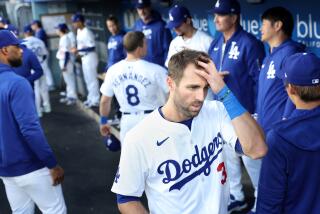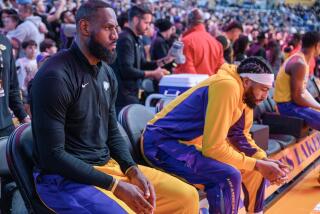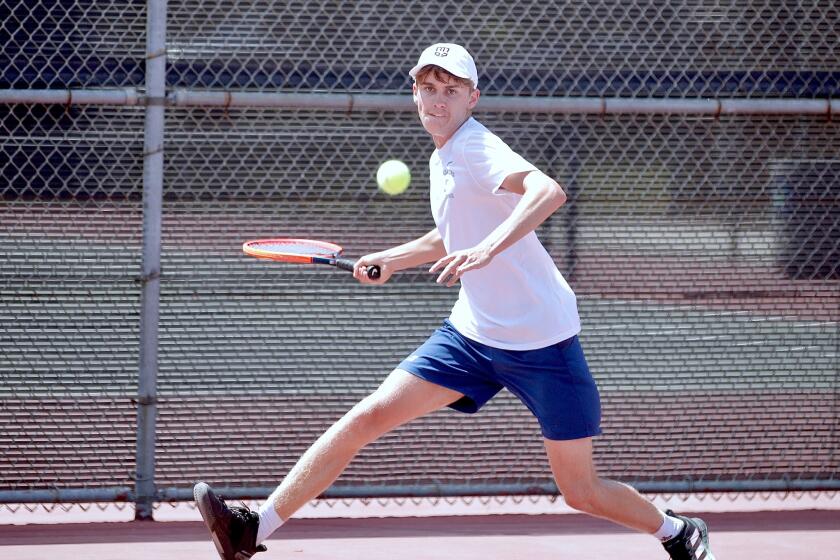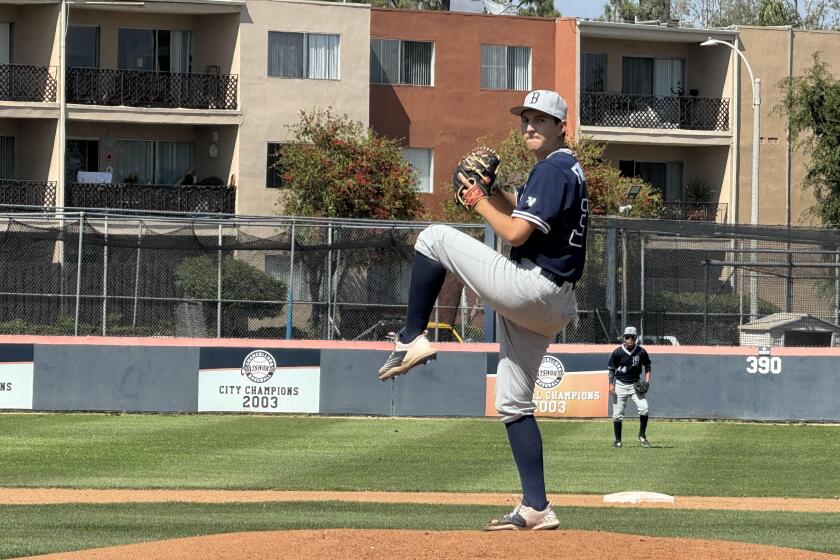Going, Going Gone: Padre Pitchers Find They Are a <i> Big</i> Hit : Giving Up Homers Getting Them Down
Those unidentified objects--presumably baseballs--that keep flying out of San Diego Jack Murphy Stadium are causing much concern. Padre pitchers are yielding home runs at such an alarming rate that, by October, they could go way down in history. . . .
Most gopher balls ever given up a pitching staff--1987 San Diego Padres.
Hoping to prevent such a catastrophe, Padre pitchers are currently trying to put their fingers on the problem. And most of them are convinced the problem is just that--what they’re putting their fingers on.
It’s the baseball, they say.
Padre pitchers have allowed 28 homers--tying them with Cleveland for the Major League high--and this is after only 20 games. At this rate, they’ll break the all-time single-season record of 220 set by the 1964 Kansas City Athletics. They swear it’s because of a livelier ball. Manager Larry Bowa lent creedence to this theory when he sawed a baseball in half before a recent game and found a little Super Ball smack in the middle.
“I don’t remember that being there before,” Bowa said.
If true, this could be a startling development. Usually baseballs have cork in the middle, not Super Balls. Headline: Baseballs are Bouncier In ’87. And if you thought Roger Maris’ record of 61 home runs was safe, guess again.
“It’s killing us pitchers,” said the Padres’ Ed Whitson, who has given up 18 hits--10 of which have been homers. “A man’s had a heck of a year this year if his ERA is in the high 3s.
“I’m not complaining. I’ll take my lumps, but it’s a shame. I know if I hit a home run, I’d want it to be legit.”
Whitson isn’t alone.
“The balls are bigger than Dallas,” Padre reliever Tom Gorman said. “Either the O-zone is going haywire, the ball is souped up or everyone in the National League is pumping iron. Did you see Lenny Dykstra (of the Mets) go out of Shea Stadium to dead center? I did. I’d only seen that twice before--Mike Schmidt and Andre Dawson. I’m sure Lenny has pop, but c’mon. . . . “
Dodger Manager Tom Lasorda said: “I don’t know if the ball is pumped up or not. I know I picked one up the other day, put it to my ear and felt a heartbeat inside. I don’t know what that meant, but maybe there’s your story.”
Lasorda winked.
According to Scott Smith of the Rawlings Sporting Goods company--they’ve been making the official Major League baseball since 1965--the specifications on the ball have never changed.
“The ball is not livelier,” Smith said. “This happens every spring, I’m telling you. Balls go flying out, and everyone thinks it’s the ball. But it doesn’t change. It’s our job to keep the ball the same every year, just for the integrity of the record books.”
Then how do you explain the Super Ball? Smith said that was no Super Ball Bowa found. What it was, he said, was cork layered with rubber. He said every baseball has two rubber layers around a cushioned cork center.
“There’s always been a rubber-coated cork center,” Smith said. “I’m telling you.”
Besides, if the ball is so lively, how come the Padres can’t hit towering home runs?
“Yeah, that’s what I want to know,” Bowa said.
And it’s not just the Padre hitters. Seymour Siwoff of the Elias Sports Bureau says there hasn’t been a truly dramatic increase in home runs this year. He said 199 home runs have been hit as of Monday (107 games), which is about the same as last season, he said.
“The players know absolutely nothing,” Siwoff said. “It’s not the ball. It’s mostly weather. There could be many, many reasons. Every once in a while, it runs in a cycle. What these people (the Padre pitchers) fail to understand what baseball is--a game. It’s not an exact science.
“They’re looking for excuses that aren’t there. There’s no reason to think there’s been a change in the ball. It’s like the Emporor’s Clothes--I’m not seeing anything (in the statistics). If we find something, it’ll be by the midway point of the season. But not now.”
So maybe, just maybe, the problem is them. Maybe Padre pitchers are challenging hitters too much. As a staff, they rank third in the National League in strikeouts, so, obviously, they’re around the plate a lot. There’s a fine line between a strike out and a home run. Sometimes, a batter takes a big swing and misses by a centimeter and strikes out. Sometimes, he hits it over the center-field wall.
“I guess it’s a combination of bad pitches and a hopped-up ball,” admitted pitcher Andy Hawkins, who has given up five homers. “We’re challenging people, too. And you get burned occasionally. But that’s better than picking at people and walking a lot of guys.”
Eric Show, who’s been known for giving up homers and has also surrendered five this season, said, “We’re fastball-slider pitchers here, and the harder you throw, the farther it goes. We’ve got a lot of guys (opposing hitters) sitting on hard stuff. . . . We’ve got to find a way to stop it. I’m keeping books on every hitter. But then, what’s the difference between four singles and a dinger? I’d rather give up solo homers than four straight singles. Less pitches and less wear and tear on the arm.”
More good theories follow:
THE AIR: In the month of April, the air is cooler, Siwoff says. In other words, balls fly out of ballparks quicker. He says he notices this every spring. It will calm down, he said.
THE STADIUM: San Diego Jack Murphy Stadium is quickly becoming known for home runs. If Atlanta’s Fulton County Stadium is “The Launching Pad,” then San Diego’s Stadium is “Jack Murphy’s Law--A routine fly ball will turn into a home run at the worst possible moment.”
Pete Rose, Cincinnati manager, noticed this. He was talking to Show when the Reds were in town recently, and he said, “What’s wrong with this place? I’ve never seen so many balls fly out of here.”
Hawkins says Jack Murphy Stadium is even worse in the daytime, that pitchers need to be flawless when pitching in the afternoon or else.
On the Padres’ most recent homestand, their pitchers gave up 20 homers in 11 games.
THE OPPONENTS: The schedule has been rough. The Padres already have played seven games against the Reds and six against the San Francisco Giants. The Reds--behind Kal Daniels, Dave Parker and Eric Davis--lead the majors with 28 home runs this season. The Giants aren’t far behind with 22, though Bowa still can’t stomach the fact that Bob Melvin, a Giant catcher, has hit four homers this year--all against San Diego.
Things are looking up, though. In a three-game series in Los Angeles this weekend, the Dodgers didn’t hit one homer off Padre pitching. And today, the Padres open a series in St. Louis’ Busch Stadium, where homers are hit about once a week.
But, the debate lives.
“They probably figure all the home runs will put fans in the seats,” Show said. “That’s why the ball is souped-up. I know when I was a kid, I wanted to see home runs. But, the ball is supposed to be a cork center. Ain’t no way.”
We’ll check back at midseason.
More to Read
Get our high school sports newsletter
Prep Rally is devoted to the SoCal high school sports experience, bringing you scores, stories and a behind-the-scenes look at what makes prep sports so popular.
You may occasionally receive promotional content from the Los Angeles Times.






